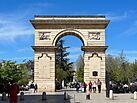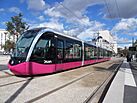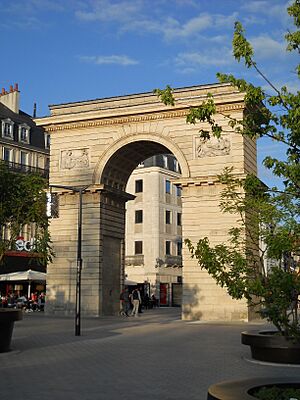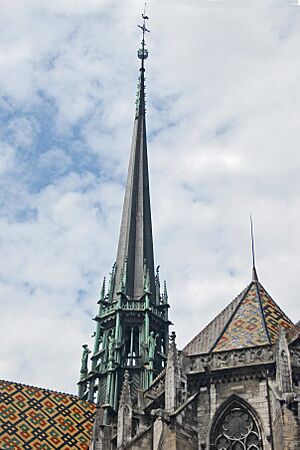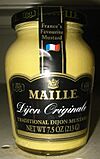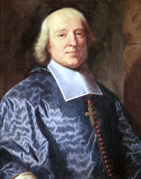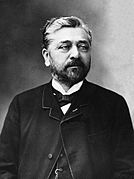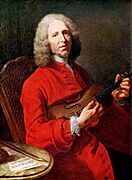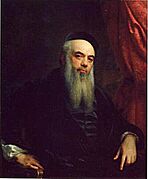Dijon facts for kids
Quick facts for kids
Dijon
|
|||
|---|---|---|---|
|
Prefecture and commune
|
|||
|
Dijon Place du Théâtre
Palace of the Dukes of Burgundy
Panorama
Jardin Darcy
Porte Guillaume
Tramway de Dijon
|
|||
|
|||
| Country | France | ||
| Region | Bourgogne-Franche-Comté | ||
| Department | Côte-d'Or | ||
| Arrondissement | Dijon | ||
| Canton | Dijon-1, 2, 3, 4, 5 and 6 | ||
| Intercommunality | Dijon Métropole | ||
| Area
1
|
40.41 km2 (15.60 sq mi) | ||
| Population
(2021)
|
159,346 | ||
| • Density | 3,943.2/km2 (10,212.9/sq mi) | ||
| Demonym(s) | Dijonnais (masculine) Dijonnaise (feminine) |
||
| Time zone | UTC+01:00 (CET) | ||
| • Summer (DST) | UTC+02:00 (CEST) | ||
| INSEE/Postal code |
21231 /21000
|
||
| Elevation | 220–410 m (720–1,350 ft) (avg. 245 m or 804 ft) |
||
| 1 French Land Register data, which excludes lakes, ponds, glaciers > 1 km2 (0.386 sq mi or 247 acres) and river estuaries. | |||
Dijon is a lively city in eastern France. It is the main city, or prefecture, of the Côte-d'Or area. It is also the capital of the Bourgogne-Franche-Comté region. In 2017, about 156,920 people lived there.
People have lived in Dijon since the Neolithic period, which was a very long time ago. Later, it became a Roman town called Divio. This town was on an important road between Lyon and Paris.
From the 11th to the 15th centuries, powerful Dukes of Burgundy made Dijon their home. During this time, Dijon became very rich and important. It was a major center for art, learning, and science in Europe.
The city still has many different architectural styles from its long history. You can see buildings from the Capetian, Gothic, and Renaissance periods. Many old houses in the city center are from the 18th century or even earlier. Dijon is famous for its special toits bourguignons, which are colorful roofs made of shiny tiles arranged in cool patterns.
Every autumn, Dijon hosts a big International and Gastronomic Fair. It also has an international flower show called Florissimo every three years. Dijon is well-known for Dijon mustard, which was first made there in 1856. The city is also a "green city" with many parks and a strong economy. It's known for food products like crême de cassis and gingerbread.
In 2015, the historic center of Dijon became a UNESCO World Heritage site. This was because of its important role in making wine in the Burgundy region.
Contents
History of Dijon: A Journey Through Time
The first signs of people living in Dijon go back to the Neolithic period. Later, the Romans built a settlement here called Divio. This name might mean "sacred fountain." It was an important stop on the road from Lyon to Paris.
For centuries, from the 1100s to the late 1400s, Dijon was home to the powerful Dukes of Burgundy. This made Dijon a very wealthy and strong city. It became a leading center for art, learning, and science in Europe. The old palace of these dukes is now the city hall and an art museum.
In 1513, armies from Switzerland and the Holy Roman Empire attacked Dijon. The city was defended by its governor, Louis II de la Trémoille. The fight was very intense, but Dijon managed to hold strong. After many talks, Louis II de la Trémoille convinced the armies to leave. The people of Dijon believed that the Virgin Mary helped them. Because of this, they started to honor Notre-Dame de Bon-Espoir (Our Lady of Good Hope).
Today, you can hardly see any signs of that siege. However, Dijon's museum of fine arts has a large tapestry. It shows the city during the siege and is a great example of 16th-century art.
Later, in 1814, armies against Napoleon occupied Dijon. The Prussian army took over in 1870–71. During World War II, Nazi Germany occupied the city from June 1940. It was bombed by US planes before the French Army and French Resistance freed it on September 11, 1944.
Geography and Climate of Dijon
Where is Dijon Located?
Dijon is in the middle of a flat area. Two small rivers, the Suzon and the Ouche, flow through it. The Suzon mostly runs underground. South of the city, you'll find hills covered in vineyards. These vineyards give the area its name, Côte-d'Or.
Dijon is about 310 kilometers (190 miles) southeast of Paris. It's also about 190 kilometers (120 miles) northwest of Geneva. And it's roughly 190 kilometers (120 miles) north of Lyon.
Dijon's Weather
Dijon has an oceanic climate, but it's also affected by being far from the coast. This means winters are cool or cold, with some frost at night. Summers are warm to hot and often humid, with many thunderstorms.
| Town | Sunshine (hours/yr) |
Rain (mm/yr) |
Snow (days/yr) |
Storm (days/yr) |
Fog (days/yr) |
|---|---|---|---|---|---|
| National average | 1,973 | 770 | 14 | 22 | 40 |
| Dijon | 1,852.8 | 759.8 | 23.2 | 27.5 | 66.8 |
| Paris | 1,661 | 637 | 12 | 18 | 10 |
| Nice | 2,724 | 767 | 1 | 29 | 1 |
| Strasbourg | 1,693 | 665 | 29 | 29 | 56 |
| Brest | 1,605 | 1,211 | 7 | 12 | 75 |
| Climate data for Dijon (1991–2020 averages, extremes 1921−present) | |||||||||||||
|---|---|---|---|---|---|---|---|---|---|---|---|---|---|
| Month | Jan | Feb | Mar | Apr | May | Jun | Jul | Aug | Sep | Oct | Nov | Dec | Year |
| Record high °C (°F) | 16.5 (61.7) |
21.1 (70.0) |
24.9 (76.8) |
29.0 (84.2) |
34.4 (93.9) |
37.3 (99.1) |
39.5 (103.1) |
39.3 (102.7) |
34.2 (93.6) |
28.3 (82.9) |
21.6 (70.9) |
17.5 (63.5) |
39.5 (103.1) |
| Mean daily maximum °C (°F) | 5.6 (42.1) |
7.6 (45.7) |
12.5 (54.5) |
16.2 (61.2) |
20.0 (68.0) |
24.2 (75.6) |
26.7 (80.1) |
26.2 (79.2) |
21.7 (71.1) |
16.1 (61.0) |
9.7 (49.5) |
6.1 (43.0) |
16.1 (61.0) |
| Daily mean °C (°F) | 2.7 (36.9) |
3.8 (38.8) |
7.5 (45.5) |
10.7 (51.3) |
14.6 (58.3) |
18.5 (65.3) |
20.8 (69.4) |
20.4 (68.7) |
16.4 (61.5) |
11.8 (53.2) |
6.5 (43.7) |
3.4 (38.1) |
11.4 (52.5) |
| Mean daily minimum °C (°F) | −0.2 (31.6) |
0.0 (32.0) |
2.6 (36.7) |
5.2 (41.4) |
9.2 (48.6) |
12.8 (55.0) |
14.9 (58.8) |
14.6 (58.3) |
11.0 (51.8) |
7.6 (45.7) |
3.3 (37.9) |
0.7 (33.3) |
6.8 (44.2) |
| Record low °C (°F) | −21.3 (−6.3) |
−22.0 (−7.6) |
−15.3 (4.5) |
−5.3 (22.5) |
−3.3 (26.1) |
0.8 (33.4) |
2.8 (37.0) |
4.3 (39.7) |
−1.6 (29.1) |
−4.9 (23.2) |
−10.6 (12.9) |
−20.8 (−5.4) |
−22.0 (−7.6) |
| Average precipitation mm (inches) | 56.8 (2.24) |
42.9 (1.69) |
48.2 (1.90) |
57.5 (2.26) |
76.1 (3.00) |
65.8 (2.59) |
64.9 (2.56) |
62.0 (2.44) |
56.4 (2.22) |
73.6 (2.90) |
77.6 (3.06) |
61.6 (2.43) |
743.4 (29.27) |
| Average precipitation days (≥ 1.0 mm) | 10.6 | 8.4 | 9.2 | 9.1 | 10.3 | 8.9 | 7.8 | 7.9 | 7.9 | 9.8 | 11.1 | 11.3 | 112.3 |
| Average relative humidity (%) | 88 | 82 | 76 | 71 | 74 | 72 | 68 | 71 | 78 | 85 | 87 | 89 | 78 |
| Mean monthly sunshine hours | 60.8 | 95.1 | 159.8 | 193.7 | 215.5 | 240.3 | 256.9 | 239.7 | 190.9 | 118.0 | 66.5 | 52.9 | 1,890 |
| Source 1: Meteo France | |||||||||||||
| Source 2: Infoclimat.fr (relative humidity 1961–1990) | |||||||||||||
Amazing Sights in Dijon
Dijon has many beautiful churches. These include Notre Dame de Dijon, St. Philibert, and Dijon Cathedral. The cathedral's crypt is over 1,000 years old! The city's buildings show many different architectural styles from the last thousand years. You can see Capetian, Gothic, and Renaissance designs. Many homes in the city center are from the 1700s or even older. Dijon is famous for its special toits bourguignons, which are colorful roofs made of glazed tiles.
Luckily, Dijon was mostly saved from damage during wars like the Franco-Prussian War and World War II. This means many old buildings, like the half-timbered houses from the 12th to 15th centuries, are still standing.
Dijon is also home to many museums. The Musée des Beaux-Arts de Dijon is in the Ducal Palace. It has old kitchens from the 1400s and a large collection of European art.
One of the most popular sights is the Ducal Palace. It's called the Palais des Ducs et des États de Bourgogne. This palace has some of the few remaining examples of Capetian architecture in the area. Many visitors also go to see the Puits de Moïse or Well of Moses. This is a huge sculpture by Claus Sluter.
The Church of Notre Dame is known for its art and architecture. A popular story says that if you touch the stone owl carving (la chouette) on the church with your left hand, it will bring you good luck.
The Grand Théâtre de Dijon was built in 1828. It's one of the main places for performances by the Opéra de Dijon. This theater was designed in the Neo-classical style. Its inside looks like Italian opera houses.
Getting Around Dijon
Roads for Travel
Dijon is about 300 kilometers (186 miles) southeast of Paris. You can drive there in about three hours using the A38 and A6 highways. Other highways connect Dijon to cities like Nancy, Lyon, Geneva, and Basel.
Waterways: Canals and Rivers
The Canal de Bourgogne goes right through the heart of Dijon. This canal connects Dijon to Paris in the northwest via the Yonne river. It also links to the Saône river to the southeast. From the Saône, you can reach the Mediterranean Sea or even Germany and central Europe through other canals. These waterways were once very important for moving goods. Today, they are mostly used by boats for fun trips.
Public Transport in Dijon
Trains Connecting Dijon
Dijon is a major train hub. Lines from Paris go through Dijon to Lyon and Marseille. There are also east-west lines to places like Besançon, Switzerland, and Italy. The main train station is Dijon-Ville station. You can take a TGV high-speed train to Paris-Gare de Lyon. This trip of 300 kilometers takes only about one hour and 40 minutes. You can also reach Lyon in two hours by regular train. There's also a direct overnight train service to Milan, Verona, and Venice.
Trams in the City
A new tram system opened in Dijon in 2012. Line T1 is 8.5 kilometers (5.3 miles) long with 16 stations. It runs from the Dijon railway station to Quetigny. Line T2 opened in December 2012. It's 11.5 kilometers (7.1 miles) long with 21 stations. This line runs north to south between Valmy and Chenôve.
Culture and Fun in Dijon
Dijon hosts its International and Gastronomic Fair every autumn. It's one of the ten biggest fairs in France, with over 500 exhibitors and 200,000 visitors. Every three years, Dijon also holds the international flower show Florissimo.
The city has many museums, including the Musée des Beaux-Arts de Dijon and the Musée Archéologique. Dijon also has about 700 hectares of parks and green spaces, like the Jardin botanique de l'Arquebuse.
Dijon is home to Le Consortium, a famous modern art center. There's also a fine-arts school and many art galleries.
For music lovers, Dijon has several popular venues. These include Le Zenith de Dijon, La Vapeur, and l'Atheneum.
Dijon mustard first came from Dijon in 1856. A man named Jean Naigeon used verjuice (sour grape juice) instead of vinegar in the recipe. Today, most Dijon mustards use white wine instead of verjuice. Even though it's called "Dijon" mustard, it doesn't have to be made in Dijon. Most of the mustard seeds used are imported, mainly from Canada.
Burgundy is a world-famous region for growing wine. Important vineyards like Vosne-Romanée are very close to Dijon. The city's university even has a special institute for studying wine. The road from Santenay to Dijon is called the "route des Grands Crus". This is where some of the world's most expensive wines are made.
The city is also known for its crème de cassis. This is a blackcurrant liqueur used in a drink called "Kir." The Kir is a mix of crème de cassis and white wine. It's named after a former mayor of Dijon, Félix Kir.
Dijon is home to the Dijon FCO football club. It has both a men's team and a women's team. Dijon also has a professional basketball team, JDA Dijon Basket. The Palais des Sports de Dijon is where the team plays. The Dijon Ducs ice hockey team also plays in the city. To the northwest, the race track of Dijon-Prenois hosts many motor sport events. It even hosted the Formula 1 French Grand Prix five times!
Colleges and Universities in Dijon
- The main campus of the University of Burgundy
- École nationale des beaux-arts de Dijon (National School of Fine Arts)
- European Campus of Sciences Po Paris
- Agrosup Dijon (a school for applied biology, nutrition, and food)
- Burgundy School of Business
Population Growth in Dijon
| Historical population | ||||||||||||||||||||||||||||||||||||||||||||||||||||||||||||||||||||||||||||||||||||||||||||||||||||||||||||||||||||||
|---|---|---|---|---|---|---|---|---|---|---|---|---|---|---|---|---|---|---|---|---|---|---|---|---|---|---|---|---|---|---|---|---|---|---|---|---|---|---|---|---|---|---|---|---|---|---|---|---|---|---|---|---|---|---|---|---|---|---|---|---|---|---|---|---|---|---|---|---|---|---|---|---|---|---|---|---|---|---|---|---|---|---|---|---|---|---|---|---|---|---|---|---|---|---|---|---|---|---|---|---|---|---|---|---|---|---|---|---|---|---|---|---|---|---|---|---|---|---|
|
|
|||||||||||||||||||||||||||||||||||||||||||||||||||||||||||||||||||||||||||||||||||||||||||||||||||||||||||||||||||||
| Source: EHESS and INSEE (1968–2021) | ||||||||||||||||||||||||||||||||||||||||||||||||||||||||||||||||||||||||||||||||||||||||||||||||||||||||||||||||||||||
Famous People from Dijon
Many interesting people were born in or lived in Dijon:
- John the Fearless (1371–1419), a Duke of Burgundy
- Philip the Good (1396-1467), another Duke of Burgundy
- Charles the Bold (1433–1477), a Duke of Burgundy
- Alexandre Gustave Eiffel (1832–1923), the engineer who designed the Eiffel Tower
- Jean-Philippe Rameau (1683–1764), a famous composer
- François Rude (1784–1855), a well-known sculptor
- Claude Jade (1948–2006), an actress
- Anne-Caroline Chausson (b. 1977), an Olympic medalist in cycling
- Julien Pillet (b. 1977), an Olympic medalist in fencing
Twin Towns and Sister Cities
Dijon has friendly connections with many cities around the world. These are called twin towns or sister cities:
 Białystok, Poland, since 1996
Białystok, Poland, since 1996 Cluj-Napoca, Romania
Cluj-Napoca, Romania Mechelen, Belgium
Mechelen, Belgium Chefchaouen, Morocco
Chefchaouen, Morocco Dakar, Senegal
Dakar, Senegal Dallas, United States, since 1957
Dallas, United States, since 1957 Guimarães, Portugal
Guimarães, Portugal Mainz, Germany, since 1958
Mainz, Germany, since 1958 Prague 6, Czech Republic
Prague 6, Czech Republic Reggio Emilia, Italy, since 1963
Reggio Emilia, Italy, since 1963 Skopje, North Macedonia, since 1961
Skopje, North Macedonia, since 1961 Volgograd, Russia, since 1960
Volgograd, Russia, since 1960 York, United Kingdom, since 1953
York, United Kingdom, since 1953
See also
 In Spanish: Dijon para niños
In Spanish: Dijon para niños






